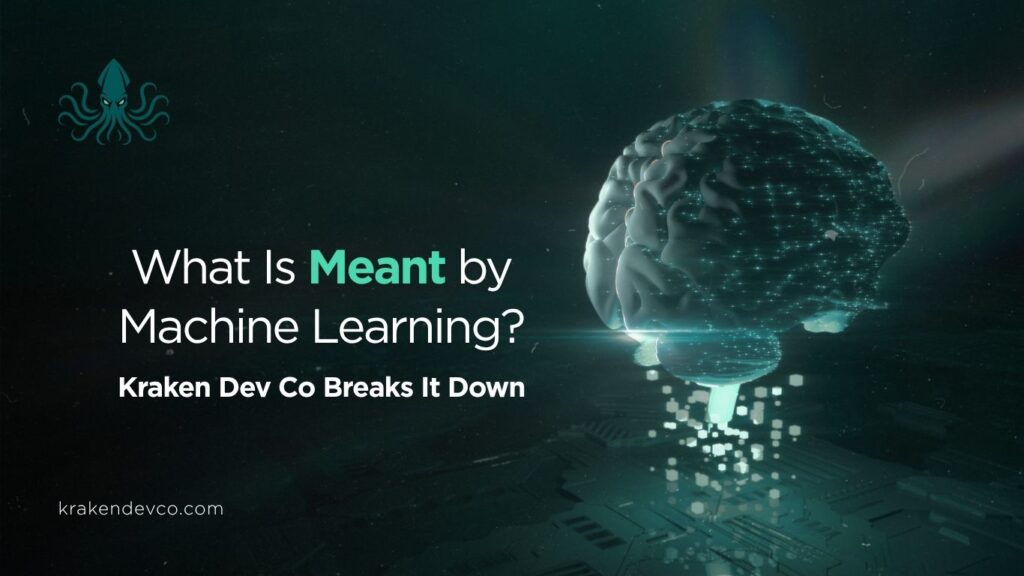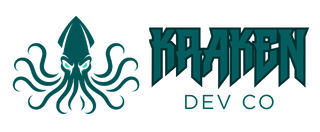
Machine Learning: The Engine Room of Smart Software
Machine learning isn’t futuristic—it’s foundational. From fraud detection and autonomous vehicles to voice assistants and recommendation engines, machine learning models are already embedded in the infrastructure of modern business. If you’re wondering what is meant by machine learning, the answer isn’t buzzwords. It’s logic, data, and continuous optimisation—built, deployed, and maintained at scale.
At Kraken Dev Co, we don’t theorise about AI systems—we build them. We design, train, deploy, and manage machine learning models to turn raw data into real-world decisions. Whether you’re integrating predictive models into enterprise applications or launching generative AI applications using Google Cloud or AWS, we architect with performance in mind.
Definition: What Machine Learning Means
Machine learning (ML) is a subfield of artificial intelligence that focuses on building systems that can learn from data, identify patterns, and make decisions with minimal human intervention. Rather than being hardcoded with specific rules, ML algorithms adapt and improve over time by processing training data and optimising internal parameters.
A typical machine learning system consists of:
- Input Layer: Where raw data (structured, unstructured, or semi-structured) is introduced.
- Hidden Layer(s): Where feature extraction and transformations occur, especially in deep learning and neural networks.
- Output Layer: Produces predictions or classifications.
- Cost Function: Measures the difference between prediction and reality.
- Optimisation Algorithm: Such as gradient descent, which tunes model weights to minimise the cost.
This pipeline—when deployed correctly—powers everything from email filters to medical imaging, speech recognition to automated stock trading.
Machine Learning vs AI vs Deep Learning
- Artificial Intelligence: The broad discipline of creating intelligent behaviour in machines.
- Machine Learning: A specific AI technique where systems learn from data instead of explicit programming.
- Deep Learning: A subset of ML that uses deep neural networks to process complex, high-dimensional data such as images, video, and human language.
At Kraken Dev Co, we distinguish between these layers not just academically, but practically—because choosing the right method determines scale, compute, and impact.
Types of Machine Learning
Machine learning is not one-size-fits-all. Different learning strategies suit different data profiles and objectives:
Supervised Learning
Trains on labelled data. Examples:
- Logistic regression for spam classification.
- Decision trees for credit scoring.
- Random forests in fraud detection.
Unsupervised Learning
No labelled outcomes—patterns emerge naturally.
- Customer segmentation using k-means clustering.
- Data mining anomalies in network security.
- Dimensionality reduction using PCA.
Semi-Supervised Learning
Combines a small amount of labelled data with a large unlabelled set. Useful in medical datasets or sensor logs where labelling is expensive.
Reinforcement Learning
The model learns via trial and error. Common in:
- Self-driving cars.
- Game simulations.
- Dynamic pricing and real-time bidding engines.
Common Machine Learning Algorithms
Different ML problems demand different tools:
- Linear Regression: For continuous prediction.
- Polynomial Regression: Captures non-linear relationships.
- Logistic Regression: Binary classification.
- Support Vector Machines (SVMs): Ideal for high-dimensional decision boundaries.
- Classification and Regression Trees (CART): Tree-based models for structured decision making.
- Random Forests: Ensemble of decision trees to reduce variance.
- Deep Neural Networks (DNNs): For high-performance tasks like image recognition, natural language processing, and generative AI.
- K-means Clustering: Pattern discovery in unstructured data.
We architect ML stacks with model selection, interpretability, and compute trade-offs in mind.
Real-World Applications We Build
Kraken Dev Co engineers ML systems that drive results—not vanity demos. Applications include:
- Voice Assistants & Voice Recognition: NLP-based assistants in mobile and embedded systems.
- Computer Vision: Image and video recognition, surveillance, medical imaging.
- Generative AI Applications: Content, code, design—all driven by foundation models.
- Customer Service Automation: AI-powered chat and ticket systems.
- Healthcare AI: Predictive disease diagnoses, treatment planning, and patient monitoring.
- Internet Search Engines: Natural language search and information ranking.
- Amazon Bedrock / Textract / Kendra: Integration of ML workloads with AWS infrastructure.
- Recommendation Engines: Built with real-time feedback loops.
- Financial Services: From risk scoring to fraud prevention using real-time ML pipelines.
- Autonomous Vehicles: Sensor data processing, route optimisation, adaptive decision-making.
From Data to Deployment: The ML Workflow
Our machine learning deployment process includes:
- Problem Definition: Regression? Classification? Anomaly detection?
- Data Ingestion: Structured data (CSV, SQL) or unstructured data (text, images, sensor logs).
- Feature Engineering: Transform raw inputs into useful representations.
- Model Selection: Choose the right algorithm—support vector machines, decision trees, DNNs, etc.
- Training: Use Jupyter Notebooks or pipelines to iterate through training data.
- Evaluation: Assess metrics like F1-score, precision, recall, AUC.
- Hyperparameter Tuning: Optimise using tools like GridSearch or Bayesian methods.
- Model Deployment: Production-grade serving via APIs or edge devices.
- Monitoring: Track drift, latency, and retraining triggers.
We also manage ML workloads on cloud platforms like Google Cloud and AWS, leveraging scalable infrastructure to optimise throughput and cost.
Why MLOps Matters
Machine learning doesn’t stop at training. MLOps ensures your model stays accurate, scalable, and auditable in production.
Key practices:
- Versioning models and datasets.
- Automated CI/CD for model rollout.
- Live monitoring for drift and failure recovery.
- Integration with platforms like MLflow, SageMaker, TFX.
MLOps is what makes a machine learning initiative sustainable—and Kraken Dev Co builds it in from day one.
The Power and Risk of Machine Learning
Advantages
- Predictive Power: Extracts insights from big data sets that humans can’t process.
- Scalability: From local models to globally distributed learning machines.
- Automation: Real-time decision-making, from customer service to logistics.
- Adaptability: Systems learn from new input data, adapting without reprogramming.
Limitations
- Data Dependence: Garbage data means garbage predictions.
- Bias Propagation: Training data reflects real-world inequality unless mitigated.
- Opaque Models: Deep models often lack transparency—explainability is key.
- Cost: Training large foundation models consumes compute at scale.
We mitigate these through careful data management, bias auditing, and explainable AI design.
Learn the Tools Behind the Machines
Want to build a career or strategy with ML? Start with:
- Python & Jupyter Notebooks
- Frameworks: TensorFlow, PyTorch, scikit-learn
- Math: Linear algebra, probability, optimisation
- Cloud ML Services: AWS Certified Machine Learning Engineer pathway, Google Cloud ML tools
- Industry Programs: MIT Executive MBA for leaders, Executive Programs for stakeholders
Kraken Dev Co also supports public engagement and organisational adoption with technical workshops and advisory.
Kraken Dev Co: Your Partner in Applied Machine Learning
We bring experience, strategy, and deep technical capability to machine learning system design and delivery. Whether you’re working with internal data, public APIs, or generative models, we engineer solutions that move beyond prototypes to production-grade ML.
From policy report analysis to business world deployment, we’re the team that builds what’s next.
Ready to architect your ML future?
Let Kraken Dev Co show you how your data becomes your edge.



